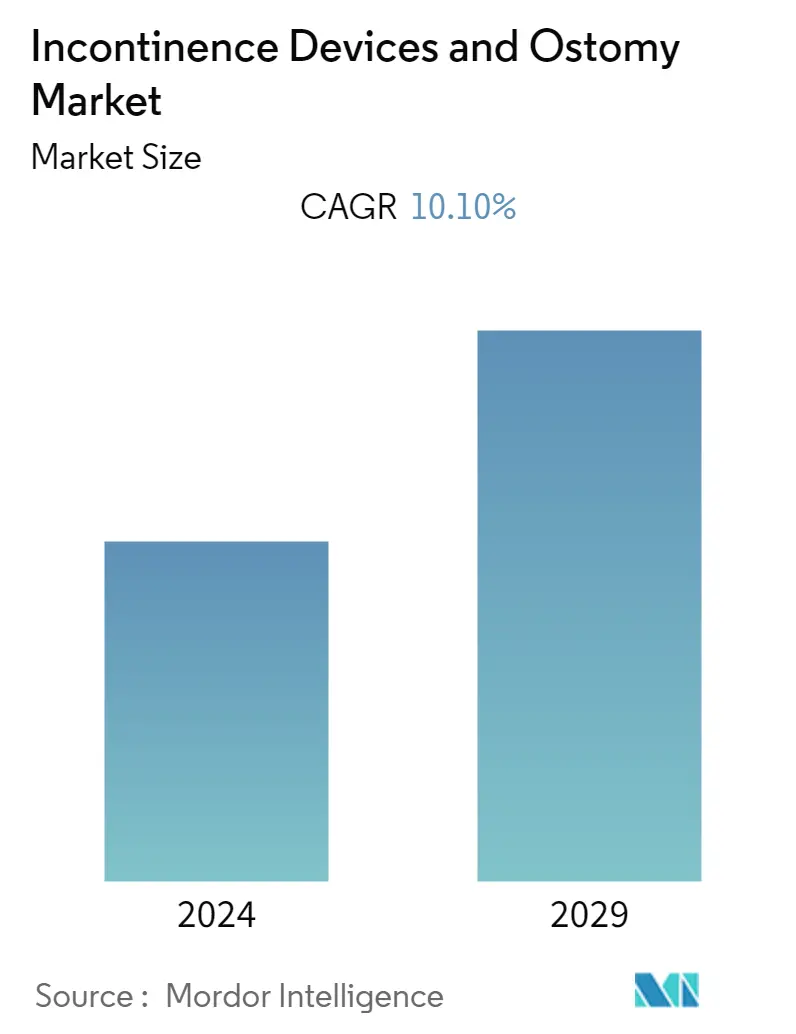Market Size of Incontinence Devices and Ostomy Industry

| Study Period | 2019 - 2029 |
| Base Year For Estimation | 2023 |
| Forecast Data Period | 2024 - 2029 |
| CAGR | 10.10 % |
| Fastest Growing Market | Asia Pacific |
| Largest Market | North America |
Major Players
*Disclaimer: Major Players sorted in no particular order |
Incontinence Devices & Ostomy Market Analysis
The incontinence and ostomy care product market is expected to register a CAGR of nearly 10.1% during the forecast period.
The outbreak of the COVID-19 pandemic significantly impacted the incontinence devices and ostomy business, as only the most acute ostomy surgeries were performed following the outbreak. Stoma care is a potentially overlooked aspect of the outbreak, and no specific stoma care recommendations were published during the pandemic. According to the study published by the National Library of Medicine in March 2022, ostomies decreased by 19.5% during the time between March 2020 and February 2021. Thus, the decline in surgeries related to ostomies hampered the growth of the market during the pandemic. However, the demand for ostomy care products for home care considerably increased during the same period as most patients opted for home treatments. Hence, COVID-19 had a significant impact on market growth. However, as COVID-19 cases have subsided, the market has been recovering very well and is likely to maintain the same trend over the forecast period.
The major factor contributing to the growth of the market studied is the high prevalence of inflammatory bowel diseases (IBD), rising prevalence of urinary incontinence (UI), including ulcerative colitis or Crohn's disease, and colorectal cancer, resulting in increased ostomy surgery cases. According to the WHO updates from July 2021, an increase of around 70% is expected in colorectal cancer cases across the world by 2030. Furthermore, according to statistics published by GLOBOCAN, colorectal cancer (CRC) is the fourth most common type of cancer among the German population, and approximately 57,528 new cases of CRC were reported in Germany in 2021. Additionally, according to statistics provided by GLOBOCAN in 2020, approximately 33,815 new cases of colon cancer and 11,951 new deaths were reported in the United Kingdom in 2020 increasing the demand for ostomy surgeries and devices, thereby boosting the market growth over the forecast period. Moreover, as per a study published in April 2022 by Female Pelvic Medicine & Reconstructive Surgery, 61.8% of women had urinary incontinence (UI), corresponding to 78,297,094 adult United States women, with 32.4% of all women reporting symptoms at least monthly in 2021. Of those with UI, 37.5% had stress urinary incontinence, 22.0% had urgency urinary incontinence, 31.3% had mixed symptoms, and 9.2% had unspecified incontinence. Thus, a high burden of UI in women is expected to increase the demand for incontinence products which is expected to boost the growth of the market over the forecast period.
The development of efficient and suitable pouching systems and associated accessories which help to improve the quality of life of ostomy patients, is expected to open up the growth horizons for the studied market over the forecast period. For instance, the company Trio Healthcare launched a silicone-based ostomy seal, Trio Siltac. This product aids in preventing leakage and protecting the skin around the stoma. Such technological advancements are anticipated to propel the market growth over the forecast period.
Furthermore, an increase in initiatives to raise awareness about ostomy in individuals further propels the growth of the market. For instance, the United Ostomy Association of America Inc. (UOAA) works to improve the quality of ostomy healthcare and promote higher standards of care in all healthcare settings. The organization commemorates World Ostomy Day on the first Saturday of October every year to raise awareness about ostomy care. Such initiatives is likely to create awareness among the general population about stoma care, thereby aiding market growth.
However, lack of proper reimbursement and complications associated with ostomy and usage of incontinence products are likely to restrain the market growth.
Incontinence Devices & Ostomy Industry Segmentation
As per the scope of the report, incontinence is the involuntary loss of urine from the bladder (known as urinary incontinence) and feces (poo) or flatus (wind) from the bowel (known as fecal incontinence). An ostomy is a surgery to create an opening (stoma) from an area inside the body to the outside. It is a procedure that allows bodily waste to pass through a surgically created stoma on the abdomen. The ostomy care products, such as skin barriers and ostomy bags, provide a means for collecting waste from a surgically diverted biological system.
The Incontinence and Ostomy Care Products Market is segmented by Product Type (Incontinence Care Products, Ostomy Care Products), Application (Bladder Cancer, Colorectal Cancer, Crohn's Disease, Kidney Stone, Chronic Kidney Failure, and Other Applications), and Geography (North America, Europe, Asia-Pacific, Middle-East and Africa, and South America). The report offers the value (in USD million) for the above segments.
| By Product Type | ||||||||||
| ||||||||||
|
| By Application | |
| Bladder Cancer | |
| Colorectal Cancer | |
| Crohn's Disease | |
| Kidney Stone | |
| Chronic Kidney Failure | |
| Other Applications |
| Geography | ||||||||
| ||||||||
| ||||||||
| ||||||||
| ||||||||
|
Incontinence Devices and Ostomy Market Size Summary
The incontinence devices and ostomy market is poised for significant growth, driven by the increasing prevalence of inflammatory bowel diseases and urinary incontinence. The market experienced a temporary setback during the COVID-19 pandemic due to a decrease in ostomy surgeries, but the demand for home care products surged as patients opted for at-home treatments. As the pandemic's impact wanes, the market is recovering and is expected to continue its upward trajectory. The rising incidence of conditions such as ulcerative colitis, Crohn's disease, and colorectal cancer is fueling the demand for ostomy surgeries and devices. Technological advancements, such as the development of improved pouching systems and accessories, are enhancing the quality of life for ostomy patients and are anticipated to further propel market growth.
North America leads the market, supported by a high number of patients with Crohn's disease and ulcerative colitis, along with increased awareness initiatives. The prevalence of urinary incontinence, particularly among women, is also contributing to market expansion in this region. Strategic initiatives by key players, such as product launches and expansions, are strengthening market positions and driving growth. The competitive landscape is marked by the presence of major companies like Abena AS, B. Braun Melsungen AG, and Coloplast Corporation, which hold substantial market shares. Despite challenges such as reimbursement issues and product complications, the market is expected to thrive, supported by ongoing innovations and awareness efforts.
Incontinence Devices and Ostomy Market Size - Table of Contents
-
1. MARKET DYNAMICS
-
1.1 Market Overview
-
1.2 Market Drivers
-
1.2.1 Increasing Incontinence Around the World
-
1.2.2 Increasing Prevalence of Renal Diseases and Nephrological Injuries
-
1.2.3 Growing Awareness and Acceptance regarding Ostomy Care Products
-
-
1.3 Market Restraints
-
1.3.1 Lack of Proper Reimbursement
-
1.3.2 Complications Associated with Ostomy and Usage of Incontinence Products
-
-
1.4 Porter's Five Forces Analysis
-
1.4.1 Threat of New Entrants
-
1.4.2 Bargaining Power of Buyers/Consumers
-
1.4.3 Bargaining Power of Suppliers
-
1.4.4 Threat of Substitute Products
-
1.4.5 Intensity of Competitive Rivalry
-
-
-
2. MARKET SEGMENTATION (Market Size by Value - USD million)
-
2.1 By Product Type
-
2.1.1 Incontinence Care Products
-
2.1.1.1 Absorbents
-
2.1.1.2 Incontinence Bags
-
2.1.1.3 Other Product Types (Clamps, Deodorizers, Cleaners, Urinals, etc.)
-
-
2.1.2 Ostomy Care Products
-
2.1.2.1 Ostomy Bags
-
2.1.2.1.1 Colostomy Bags
-
2.1.2.1.2 Ileostomy Bags
-
2.1.2.1.3 Urostomy Bags
-
-
2.1.2.2 Skin Barriers
-
2.1.2.3 Irrigation Products
-
2.1.2.4 Other Ostomy Products
-
-
-
2.2 By Application
-
2.2.1 Bladder Cancer
-
2.2.2 Colorectal Cancer
-
2.2.3 Crohn's Disease
-
2.2.4 Kidney Stone
-
2.2.5 Chronic Kidney Failure
-
2.2.6 Other Applications
-
-
2.3 Geography
-
2.3.1 North America
-
2.3.1.1 United States
-
2.3.1.2 Canada
-
2.3.1.3 Mexico
-
-
2.3.2 Europe
-
2.3.2.1 Germany
-
2.3.2.2 United Kingdom
-
2.3.2.3 France
-
2.3.2.4 Italy
-
2.3.2.5 Spain
-
2.3.2.6 Rest of Europe
-
-
2.3.3 Asia-Pacific
-
2.3.3.1 China
-
2.3.3.2 Japan
-
2.3.3.3 India
-
2.3.3.4 Australia
-
2.3.3.5 South Korea
-
2.3.3.6 Rest of Asia-Pacific
-
-
2.3.4 Middle East and Africa
-
2.3.4.1 GCC
-
2.3.4.2 South Africa
-
2.3.4.3 Rest of Middle East and Africa
-
-
2.3.5 South America
-
2.3.5.1 Brazil
-
2.3.5.2 Argentina
-
2.3.5.3 Rest of South America
-
-
-
Incontinence Devices and Ostomy Market Size FAQs
What is the current Incontinence Devices and Ostomy Market size?
The Incontinence Devices and Ostomy Market is projected to register a CAGR of 10.10% during the forecast period (2024-2029)
Who are the key players in Incontinence Devices and Ostomy Market?
Kimberly-Clark Corporation, Unicharm Corporation, Coloplast Corporation, Hollister Inc. and B. Braun Melsungen AG are the major companies operating in the Incontinence Devices and Ostomy Market.

